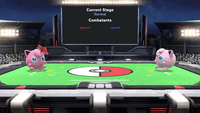
Jigglypuff's Rollout, its neutral special in every Smash Bros. title since Melee, is an example of an approaching attack.
Approaching attacks are attacks that move the character a considerable distance while simultaneously having a damaging hitbox and/or grabbox. Thus, these attacks provide a good, possibly hard to predict, and sometimes safe approach option through offensive strategy rather than walking, running, jumping, etc. However, such moves can often be very easy to punish if the opponent anticipates them, though a move's punishability is on a case-by-case basis. The most basic examples of approaching attacks attack would be dash attacks and dash grabs. Also, some approach attacks are special moves, which often but not always means that they can be used for recovery.